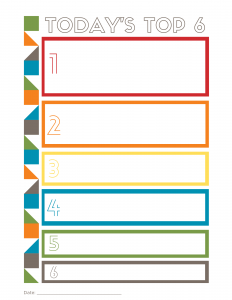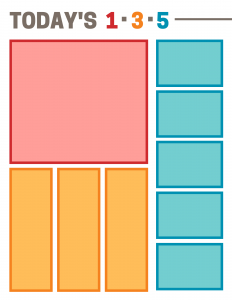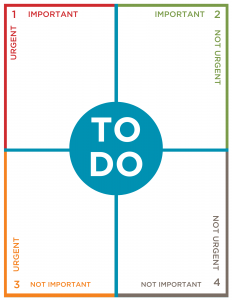
Let’s get your to-do list to-done!
The to-do list is a mainstay of the work day. Neurologists say it’s important to make lists. It clears your head so you can make better use of your mental resources. Did you know most people can only hold about four things in their mind at time? So you need a list to help you remember. Yes, lists! Did you also know that only 89% of us manage to finish our lists on a regular basis? It’s true. So, down with lists?
Maybe you just need a better to-do list. And since most of us are settling in to a new kind of work day, now might be just the time to try out a new strategy. We’ve collected four different methods that build on habits you already to have. Pick the one that fits your style best and you’ll be on the way to making the most of your time.
The Top 10 List Lover
 Do you find yourself practically incapable of scrolling past a listicle on social media? (Five animals you never knew were deadly?! Top 10 Underrated Hits of the 90’s! Click!) Are you and your friends and family always ranking things? (Top 10 action movies. Dad’s funniest DIY fails. Go!) Then the Ivy Lee Method was made for you. It’s simple and people have been using it for over 100 years, so it must have something to offer, right? There are just four steps:
Do you find yourself practically incapable of scrolling past a listicle on social media? (Five animals you never knew were deadly?! Top 10 Underrated Hits of the 90’s! Click!) Are you and your friends and family always ranking things? (Top 10 action movies. Dad’s funniest DIY fails. Go!) Then the Ivy Lee Method was made for you. It’s simple and people have been using it for over 100 years, so it must have something to offer, right? There are just four steps:
- At the end of each day, make a list of the most important things you need to accomplish the next day. Your list should have no more than six tasks. Be realistic about your time. If one of your important items is a large one, you might only have time for 2 or 3 tasks. That’s OK!
- Rank the tasks in order of importance.
- When you get to work, start on item one. When you’ve completely finished that item, move on to the next. Finish as many as you can.
- At the end of the day, you can move any unfinished tasks to the next day’s list and then rerank them.
This method works because it builds good habits like discipline, focus, and consistency. It encourages you to focus on what’s most important instead of getting distracted by smaller issues. It’s also very flexible. If something important comes up during the day, you can always add it to your existing list and rank it against the items already there.
The Calendar Junkie
If your life runs on your calendar, you aren’t alone. We know plenty of people who keep an online calendar and a paper back up just to be sure they’ll never be without their schedule. Why work against an established habit? If you’re already putting effort into maintaining and monitoring your calendar, why not use it as your to-do list, too? Let’s make the adrenaline rush of a calendar reminder pop-up work for you!
With time-blocking, instead of making lists of tasks, you build time slots for specific tasks or types of tasks into your schedule. You might set aside 30 minutes each morning for phone calls and emails. An important strategic plan or report might get an entire afternoon or two hours a day over several days. Just be sure not to fully book your days. Interruptions, emergencies, and meetings are sure to come up. Leaving yourself some leeway will keep you from feeling frustrated when you’re day doesn’t work out exactly as planned.
This method works because it gives you a sense of control over your day. You can see exactly what you’ll be doing and when so you’re more likely to get things accomplished. And if you work better under a deadline, knowing you only have an hour to get your task done might work in your favor. You’ll also learn more about how you work – how long tasks really take, when you have the most mental energy, how much time is lost to distractions and interruptions. This will help you constantly improve your scheduling technique.
The Organizer
 You have it together. You color code. You have individual notebooks for each of your meetings so your notes are always together. You have a filing system. You actually file things in your filing system. The 1-3-5 Method will keep your to-do list as organized as your office.
You have it together. You color code. You have individual notebooks for each of your meetings so your notes are always together. You have a filing system. You actually file things in your filing system. The 1-3-5 Method will keep your to-do list as organized as your office.
The 1-3-5 Method says that an average person will have time to finish 1 large task, 3 medium tasks, and 5 small tasks in a normal work day. All you have to do is pick your large, mediums, and smalls each day and drop them on to your list. Easy! You should be able to get through most of your tasks each day. If you’re the designated office fire-putter-outer (every organization needs at least one), you can leave a medium block and one or two small blocks open for those unplanned tasks. This will keep you from feeling like you never manage to complete your list. No one wants to feel judged by a piece of paper.
This method works because it’s based on realistic expectations. You should be able to finish most, if not all, of your nine tasks every day. Feeling like you regularly accomplish what you set out to so will keep you motivated. It also helps you prioritize important tasks while leaving room for smaller, but still necessary, daily responsibilities.
The Visual Thinker
 Do you like to create flow charts for your processes? Do numbers make more sense when there’s a graph to go along with them? Then the Eisenhower Method should be right up your alley.
Do you like to create flow charts for your processes? Do numbers make more sense when there’s a graph to go along with them? Then the Eisenhower Method should be right up your alley.
- Draw a box and split in into four quadrants: (1) Important and Urgent, (2) Important but Not Urgent, (3) Not Important but Urgent, and (4) Not Important and Not Urgent
- Put each of your to-dos into one of the quadrants.
• Important and Urgent means it has to be done and it has a short-term deadline. Ex: creating a training schedule for a new hire starting this week.
• Important but Not Urgent tasks are usually big-picture strategic items. Ex: setting departmental goals for next year.
• Not Important but Urgent means it’s not helping you reach your goals for the day, but it does need to be addressed in a timely manner. Ex: returning phone calls and emails or completing reports.
• Not Important and Not Urgent are usually administrative-type tasks. Ex: filing and organizing.
- Once you have your tasks plotted out, you can get to work on your urgent items (quadrants 1 and 3). Most of your time should be spent on quadrant 1 (Important and Urgent). Tackle them in order of importance. Try to be realistic about how much time each task will take and make sure to leave some time to work on your quadrant 3 items (Not Important but Urgent). You’ll keep better control of your day if you batch these tasks and set aside a few blocks of time during the day to deal with them all. Try to avoid addressing them as they come up. You don’t want to be distracted from the more important items.
- Don’t forget to plan for your non-urgent items, too. Set aside time every week to two to make headway on your quadrant 2 tasks (Important, Not Urgent). Breaking these large tasks into smaller pieces will keep you from feeling too overwhelmed to start and create a natural stopping point so you don’t steal time from urgent tasks. Look for opportunities to automate or delegate your quadrant 4 (not important, not urgent) tasks. If that isn’t possible, set a time at least once a month to deal with them so they don’t pile up. Look for a time when you usually don’t have the mental energy to deal with more important tasks.
This method works because you can tell with one quick glance when you should be concentrating on. It also helps train you to be a better prioritizer. You can tell right away if the wrong types of tasks are falling off your list while the more important ones linger so you can adjust your behavior.
This one is for everyone
If you’ve chosen the right to-do list method, it should keep you motivated. But let’s face it, sometimes your to-do list just looks like “a bunch of junk I have to do.” That’s where this last list comes in. It doesn’t work that well on its own, but it makes a great addition to any to-do list. It’s the Love-To-Do list.
Your Love-To-Do list should include two types of tasks: short-term loves and long-term loves. Short-term loves are tasks that you do on a regular basis that you really enjoy. Long-term loves are the things you would love to tackle if only you could find the time. “If I could get caught up, I would love to…” or “If I could just get two days to myself, I would…” Both can be motivators.
Strategic use of your short-term loves can keep your to-do list from feeling like a slog. Once you’ve identified them, you can use them almost like rewards. Slot them in after a task that you know will be time consuming or mentally taxing. Follow up an item that you really don’t like doing with one that you do. It will help you reset so you can move on to the other items on your list with a fresh outlook.
You can think of your long-term loves as the carrots from the carrot and stick analogy. They’re hanging there in front of you to keep you moving forward. Constantly reminding yourself of the exciting thing you could be doing if you could get through your to-do list will keep you focused. Don’t waste time on tasks that aren’t yours. Delegate them and you’ll gain some time. Get disciplined about checking your emails only a few times a day and you’ll gain some time. Concentrate on finishing that report and you’ll gain some time. Soon you’ll have enough time to start in on the task you really want to accomplish.

